In the centre of Downtown Markham stands a beacon of sustainability and a testament to public art. Aptly named “The Pride of Canada,” the beacon of cultural engagement is a 50-foot wide, expertly crafted and rideable piece of art. When The Remington Group, one of Canada’s premier development firms, began developing this brand new city centre just north of Toronto, they commissioned the work to stand as a centrepiece. The combined efforts of sculptor Patrick Amiot, artist Brigitte Laurent, and world-renowned carousel expert Daniel Horenberger produced the kinetic masterpiece you see today.

The Carousel is located at 8080 Birchmount Road, Markham, the centre of a thriving community. Adorned with 44 uniquely designed figures to ride, the Carousel is a beautiful parade of oddities. Amiot’s work is usually stationary, making his steel sculptures heavy with gravitas and responsive to their specific environment. His work for the Carousel could not be more opposed to this sentiment, each sculpture blending into a sea of moving images carried by an invisible but fluid tide. Laurent’s paintwork demonstrates clear intentionality, ensuring each individual sculpture is discernible but weaving them together in harmony. Amiot’s use of entirely recycled materials, or “junk art” focus, actually contributes to this paradoxical composition. Rideable ducks are easily recognizable as they float by, but they stray from realism with their oversized metal heads. Those same oversized heads give them strong identities as they accompany a grand ship around the Carousel, allowing these common birds to rise to the occasion.
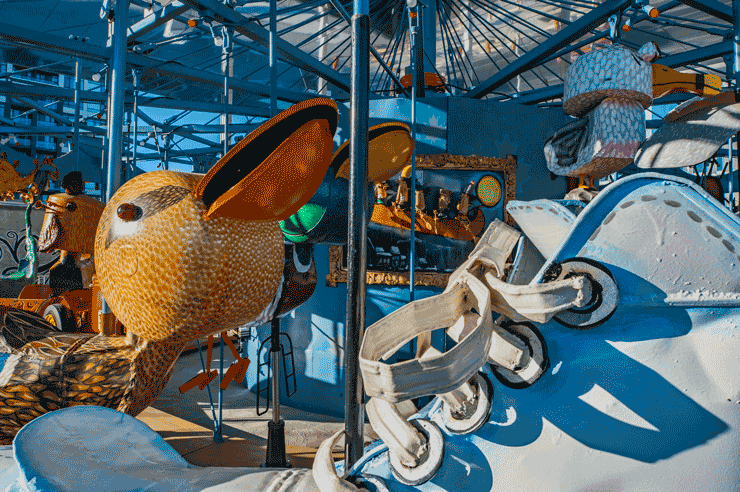
What truly breathes life into this sea of eclectic characters is the natural motion of the Carousel and Amiot’s ability to form metal sculptures that float by onlookers as if they were weightless, unencumbered by the burden of representing Canada. Each piece is playful, visually strange and surprising, and each turn of the Carousel means to delight viewers. Standing in one spot, viewers watch the images fly by as if they were in a cinema, the exaggerated features of these sculptures drawing eyes from one point to the next. Every sculpture is meant to play a temporary part in a greater performance, complementing each other, posing contrasts visually and ideologically, but coming together to articulate the singular identity of Canada. Observing the Carousel’s movements is just as enriching as participating in its parade, both an aesthetic blur of motion and colour. The actual concept of the Carousel is ingenious–viewers watch as the concept of Canada unfolds before their eyes, grabbing their attention with quirky details in each piece. It’s a feast for the eyes, the perfect attention-grabbing structure for Downtown Markham, which, similar to the Carousel, unfolded to reveal the wonders and innovation of Canada.
Arts Help Managing Editor Hannah Chew sat down with Patrick Amiot to discuss his work flow and wonderful creations.
Can you tell me about your background as an artist and your work?
I was born and raised in Canada, but I now live in Northern California. I am self-taught and started sculpting and making artwork when I was quite young. My wife, who is my painter, my best friend, and the mother of my children, is self-taught as well. We both started our careers in Vancouver, Canada, we've been working together for decades now.
You are often described as an “urban folk artist,” how do you see your work fitting into the modern narrative of American art?
I chose the “urban folk artist” label myself because I had to label myself when I moved to California and started producing calendars to help raise money for schools. When they asked me to describe it, I added “urban” because folk artists that I'm familiar with in Canada live very far from the cities and have their own little ways of working. I'm talking particularly about the ones in the Maritimes–I’m particularly fond of them.
But I thought to myself, I can't be a folk artist because I know too much. I have a lot of education, I've travelled, I speak many languages, and I have glimpsed many places. For the “folk artist” title, I have too much knowledge. So I turned to the label of “urban” folk artist. I find that when I have to label myself, I'm most comfortable with that.
In terms of my work, my dealer in Colorado likes to say my work is cutting edge. I always disagree. What he means to say by “cutting edge” is that I'm recycling in a part of America where recycling culture is still sort of awakening. Recycling in art has been happening forever in third world countries because they had fewer options, but here it’s just now becoming popular. It's obvious that sooner or later, we will have to address that only using new materials to make art will become an obsolete practice. There’s just not enough for everyone, and there's so much stuff we're throwing away. Living in California has been heaven for me because there's so much material and stuff discarded. There’s also an audience for it because the population in California is so large, and the waste problem is capturing attention.
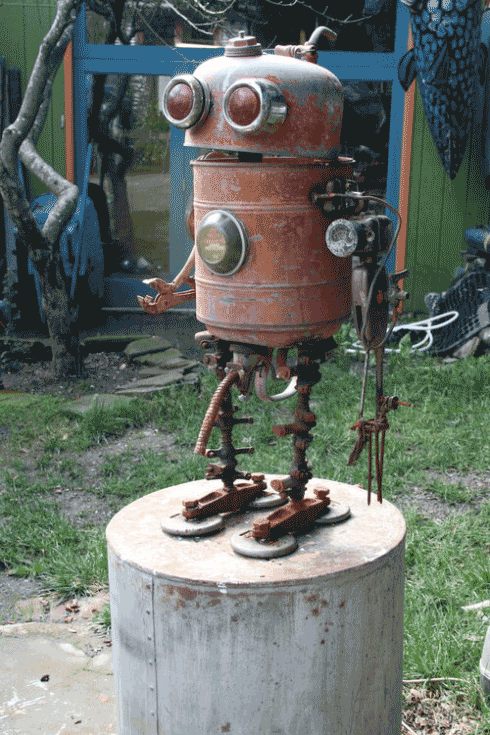
Your junk art emphasizes materiality. How does it consider and play with the unique histories of the objects you work with? Does the functionality of these everyday objects inform any of your creative decisions?
For me, I work on a lot of commissions. When people say they want me to make their dog, their husband, their family, or whatever it is, I have to focus more on the objects. For example, I've encountered people that have lost loved ones and have asked me to reach the spirit of their loved ones through the stuff they left behind. If there are toolboxes or a shed and all the stuff that was abandoned by that person, I will use it to recreate the spirit of them.
Some people don't really care that it's made out of recycled materials; they’re more interested in the brightness, the colour, and the movement. But others are way more interested in the fact that it's recycled material and the fact that it's a piece of art meant to be in my community. There's a lot of people that want a piece of art because it represents recycling while being whimsical and fun.
In terms of functionality, for instance, one day, this doctor came in and gave me all kinds of tools; some of them are pretty creepy but really cool. I ended up making an ambulance out of them. For some people, they could look at it and enjoy the colour and the chrome details. But when they look closer, they see the actual content and how it was a nice way of using the instruments.
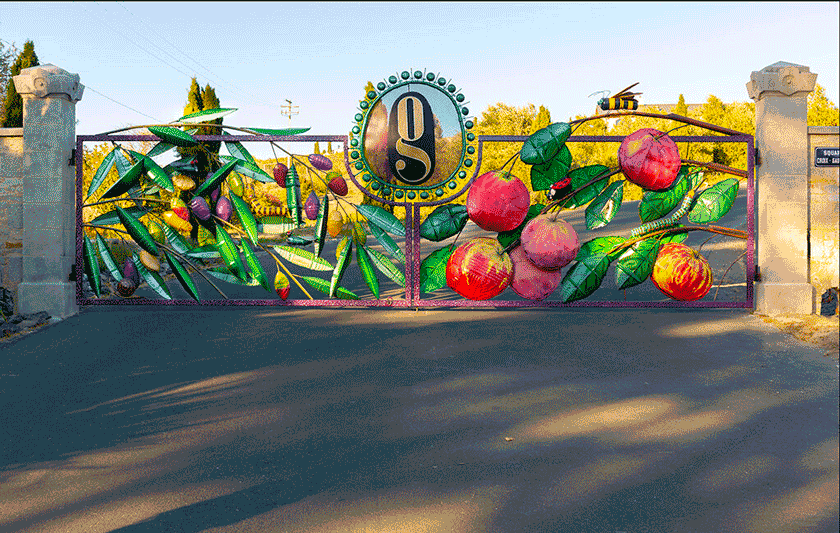
Since your work is quite literally christened “junk art,” is the intention behind your material choice one of sustainability? How has the desire to use discarded objects changed your ideas of what constitutes an artistic medium?
When I moved to California, I never thought I'd be able to make a living out of making my art. At first, I was really attached to old refrigerators, I thought they were very beautiful and very well crafted. It was a real waste to throw them away just because they didn't work because they were still good material. The same thing applies to certain car parts that I found on my early outings. I saw waste everywhere. It was so all of a sudden–this only happened in California because, in Canada, I wasn’t able to find the same materials. I was mostly a ceramic artist, and the market was very different in Canada.
I was so excited to hang onto these metal pieces that I felt were very beautiful. They reminded me of certain images, and that's pretty much how my ideas and creations started. I personally enjoy the craftsmanship of steel, and I could transform it into something funny and quirky. If you ever drive in my town, we have a whole street of my coloured sculptures. Every resident in my community has one of my pieces, and that's been a great experience. To look outside my window right now and see a whole bunch of them on my street, with each of them related to people living in that house, it's really fun.
In addition to your donations to Sebastopol schools and community funds, you have noted that you want to make artworks “indigenous to the community.” Can you elaborate more on this sentiment?
I was just trying to find a community when I moved here. In an urban setting and Montreal, it was very much a “front yard” culture. When I moved to California, it was definitely more of a “backyard” culture, which means that nobody was ever on the sidewalks, and there is not much interaction between homes. I was longing for my past life after a while.
I started putting my work in my front yard to interact with those who are passing by. Of course, years later, it's completely the opposite of what it was when I moved here! On weekends, my street is packed with people walking up and down, bringing their kids, driving up slowly, and enjoying the artwork. My goal is really to do something fun and to get involved with my community, which I have managed with my art.
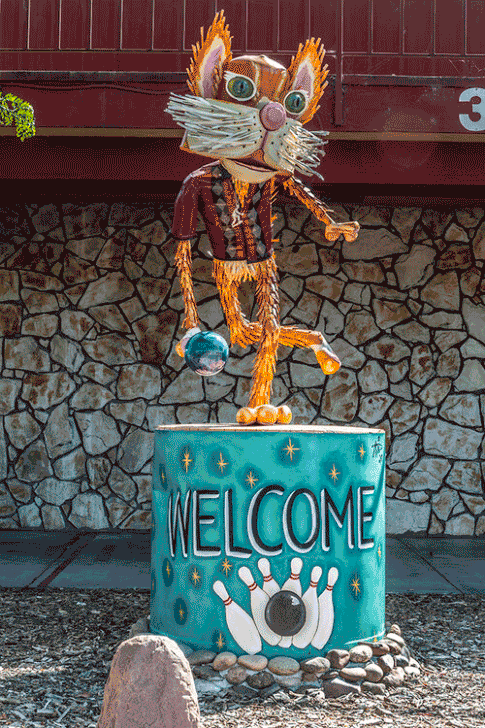
Your works have been integrated into the fabric of Sebastopol itself, but how do you perceive your own role as an artist in the community to be? Does it intersect with your role as a citizen?
My art has certainly influenced me a lot. For instance, we (myself and a committee) produce a calendar every year. The calendar raises funds for the local schools and features pictures of my sculptures. We’ve been doing this for over 12 years and raised like $700,000 or $800,000, which is a huge deal for such a small community. It's really given me this great feeling of belonging because it's not always easy to give, but this town allowed me to do what I want. It’s made me feel more at home than I've ever been anywhere else. I can't see myself leaving anymore, just because this connection between the communities, the fact that they accepted my eccentric ways and embraced it makes it a once in a lifetime thing. The community was very much progressive and sensitive to recycling. It really supported me, and today, it's nice to meet all kinds of neighbours and people in the community that share with me that my work makes our town special, and I feel very proud of it.
With the expansion of your work, you spoke of a public element. What, do you suppose, is the intended relationship between your work and its viewers? What is the intended relationship between your work and the community that has adopted and claimed it?
It's funny because I'm having these moments of new reflection in my life. When I look back, the ultimate thrill is really to share. The street has been such a great opportunity because I remember at the beginning just making these crazy things and giggling as I brought them to my front yard. I was looking at people driving up and down to see their reaction. That, to me, is more important than making a living. Being able to witness people stopping and laughing and just being amazed, is what it’s about to me. I still feel the same way every time I finish a new piece. I can't wait for people to see it, even if it's still wet with paint. Some people have this urge to share, and some people are quite happy in their little world and don't feel the desire to drag people in their homes, in their backyard. I am the first type of person.
I appeal to all classes. My work is not an elitist thing. People tell me I should put my work in a big museum. To me, it’s just so elitist, while here I can show my work to families of all different classes and backgrounds. They all go up and down the street with a smile, and the juxtaposition of the art in front of just an ordinary street is just so much fun for everyone.
The most important part of this process was being able to convince a whole street to participate. Considering that in this day and age, where people can't even agree on simple issues or housing matters, some of my neighbors, who don't talk to each other, but still have a sculpture for their home, it’s amazing. Everybody sort of agreed to have my work in front of their house, even though some of them are 12 feet tall.

From the Holstein cow to Sebastopol’s fisherman, your works are rather impressive and grandiose. Does your attention to scale serve a functional purpose, or is it a deliberate aesthetic choice?
I think it's a little bit of a complex, having worked with clay for the first few years of my life. The pleasure, of course, when you put something in the front yard, is that there's a lot of room. When you put something in somebody's living room, size is very limited and I feel out of control. In the beginning, I loved the size and went crazy with it. Now I don’t need to make my work so big anymore, the Carousel project really impacted me.
Size always affects the budget. I want to make sure everybody who wants one of my works gets one, so sometimes a budget will change my work with respect to size. The deal is if you live on my street, my work is free. For the rest of the community, they still get a majorly discounted price. Some of them have very little money to spend on my work, so I’m always open to making things smaller.
Your partner, Brigitte Laurent, paints most of your works. What is the creative process and flow between the two of you? How do you reconcile your two different artistic voices?
Oh, it's incredible! We've been working for 40 years now. I don't even have to talk anymore. She totally understands colouring, and my daughter has started joining me in welding, so it's become a family thing. I don't have the same energy that I had when I was younger, but now it's like the three of us are a little team.
Brigitte is completely in charge of the colors, and she's definitely better at painting than me. Even my daughter is way better than me at welding! I'm an artist. I don't really have the patience to and take the time to do it well.
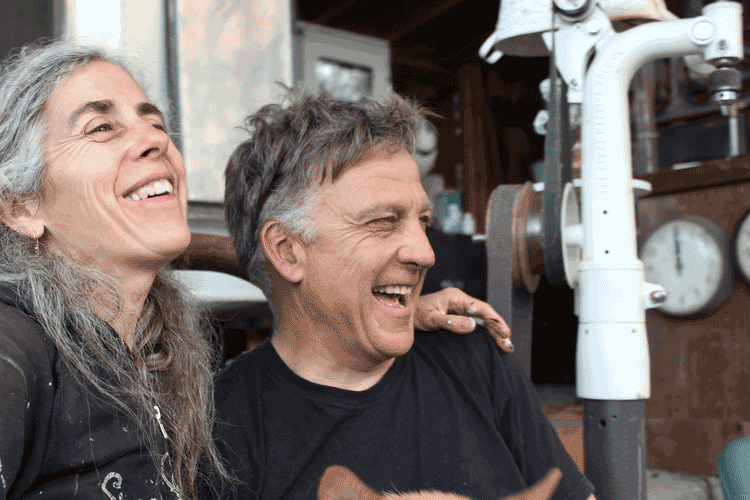
In the past, you were a prolific gallery ceramicist, a form that seems at odds with your current pursuits. Does your background as a ceramic artist inform your current work? How has the transition between materials changed your conception of artmaking?
It’s funny, I actually think they're very similar. Clay is really a free form, you can squeeze it and twist it and clay is just dough waiting to be formed. As I’ve told you, I’m not very patient, so clay was an easier medium. As a kid, I wasn't very good at school, but I could tell stories with clay without much training. Steel is the same way; it’s very forgiving, any idiot could do it.
Once you’ve bonded these pieces of steel together, they last a lifetime. Whereas wood is not forgiving, or marble, one wrong hit can take off a whole chunk. Steel is easier to work with, and with plasma cutters and my tools, I can cut steel instantly. I will twist, patch, and weld parts over and over again many times before the sculpture is even finished.
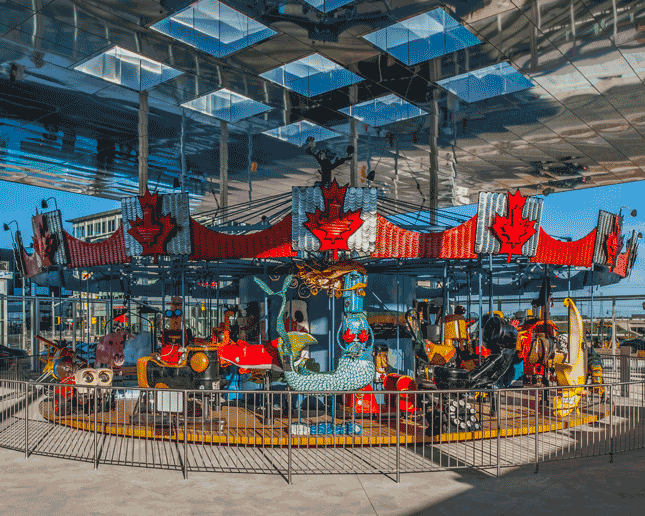
Downtown Markham is a testament to new development and a home for art, how does the Carousel act as a centrepiece for this?
Well, it was an interesting process. When The Remington Group started with Downtown Markham and the Carousel, I don't think they were really thinking about recycling, but ended up loving the idea. It's big, it’s bold, and it attracts people.
The first relationship I had with Mr. Bratty was when he came across my sculpture of a baseball player, and he just fell in love with it. one of those things where it just caught him. I think he had a soft spot for the quirky work, but I don't think his liking was only based on the fact that it's recycled, and he wanted me to be a part of the project.
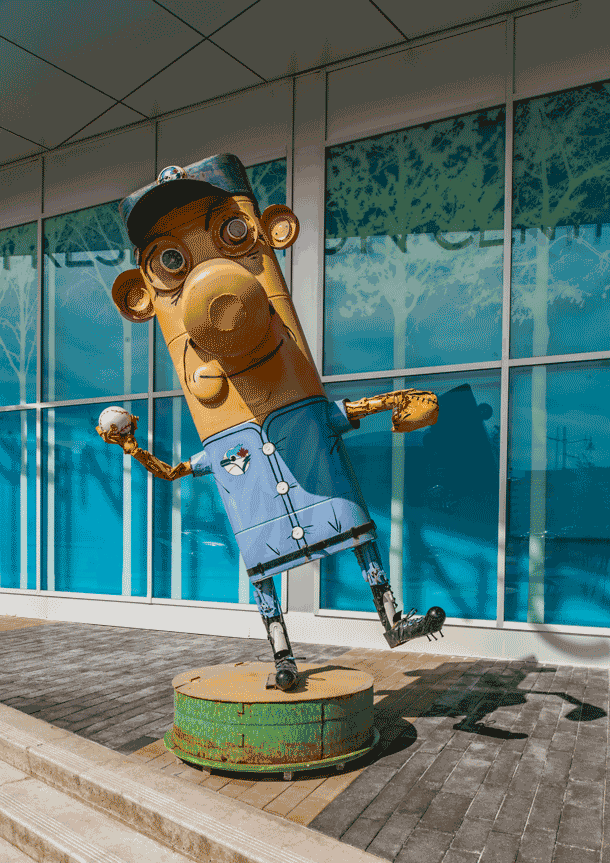
When we started, I stuck to my guns and told everyone I didn't want to buy anything for the Carousel, everything had to be recycled material. And it's not easy to make things out of found objects, I know that it’s way easier to go to the steel store and purchase the parts you want. But in this case, I think he understood what I wanted to do, and the project grew on everyone. It was celebrating Canada, but using found objects. Not an entirely new idea in the world, Cuban and African artists have been doing this forever, but certainly one of the first found object projects of that size in Canada.
The Pride of Canada Carousel is a wonderful tribute. How did you select the 44 figures while balancing the burden of crafting an accurate historical narrative and creating a community object?
What even is Canada? After you’ve put the moose and beaver up, it’s a tough question. This was the second time I’d been faced with this type of project. In my early 20’s, I was asked to go to Vancouver and do a similar thing to celebrate Canada. I tried really hard when I was younger, but what I realized during this project was that something could be Canadian without being solely Canadian. There are many things that are indigenous to many places in the world, and with over 80 sculptures to do (the Carousel figures and the wall reliefs), I had to let go.
So, I went with chickens! Chickens are Canadian, but there’s also chickens all over the world. Same for the moon I added. I remember the moon as part of my upbringing, and really went back to my childhood to find inspiration. Even though I started traditionally Canadian, I ended up using lots of other elements, and looking at it now, I feel quite comfortable and happy with how it turned out.
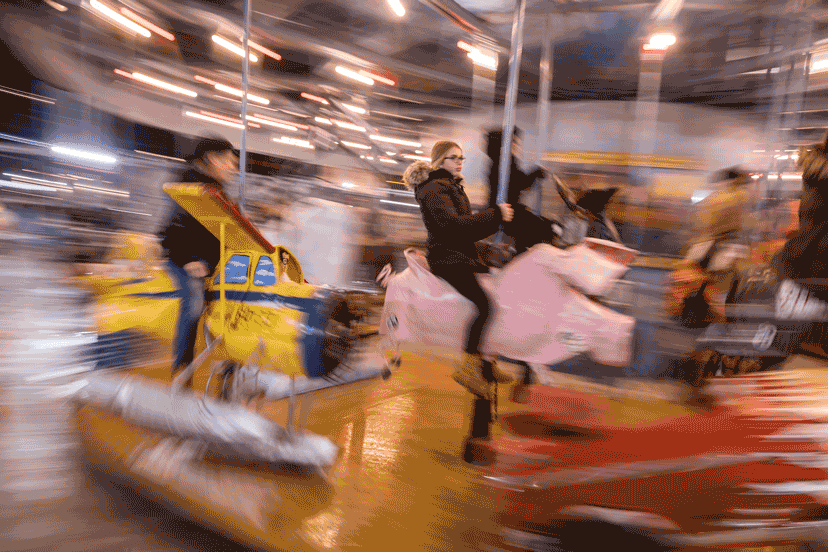
Unlike other artworks, the Carousel is meant to continually be in motion, a dynamic story to be viewed from all sides. How did this emphasis on movement and temporality inform your design?
Well, of course, this was a new thing for me. I had to work on it, but I couldn’t see it move until it was fully installed because there was no way we could have moved more than a quarter turn before it was completely finished. There was a lot I had to just imagine, and my coworker that was in charge of all the mechanics was very helpful, and he really guided me. I was worried that it was made of steel and would hurt people or not turn, but he was good at taking the pressure off of me and helping me move forward.
The process was wonderful because I was understanding more as I kept building. The first piece I made was the Mountie, but by the blue spaceship, you can see that I loosened up. Most carousels are just horses or animals, but I got nostalgic, and discovered I could include things from carnival rides.
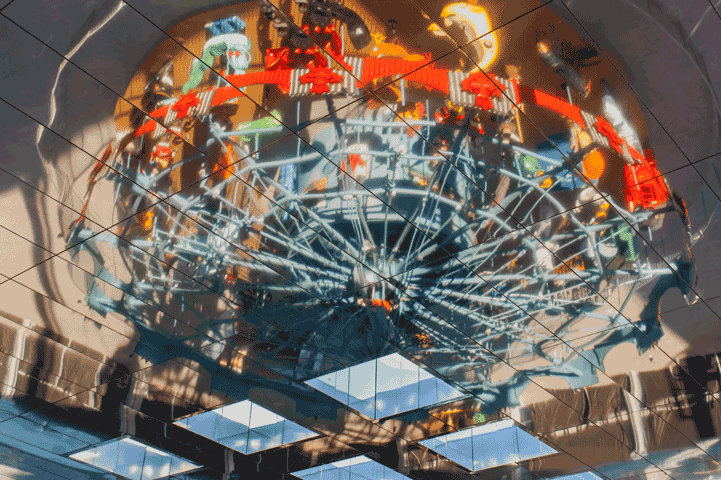
Daniel Horenberger collaborated with you on the project. How did your visions come together? Can you walk me through evidence of your collaborations?
I really worked a lot with Daniel. He was really my guy, we were both in California, and we were both working on the same parts of the Carousel. Dan was awesome, he had such cool shit! I went over to his place in Los Angeles and had an amazing collection. I can’t describe the joy I had just looking at his collection. He started building carousels in his early 20’s and sent me to somewhere called the House on the Rock to see the largest carousel in the world.
Dan was the guy who really helped me out. I was always in the dark, and even when they called me to offer me the job, I was lost, and the first thing I did was go see Dan. He really helped me out, and every time I called him, I felt better.
As a lifetime artist, what is your advice to budding creators?
Haha! That’s a funny one, giving advice. When you're passionate about something, it seems like nothing else matters, but I also know that so many of my peers struggle. I don't know if it's just luck; sometimes, I think it's just because I met the right person when I was young, and she truly supported me in this whole process. It's such a hard, difficult life, but it's so rewarding, and now my daughter, who's 30, is somewhat of an artist, and I don't even know what to tell her. It's all about being in the right place at the right time. And for me, travelling in Canada, I was fortunate enough to go to Toronto for two for three years in the late 80s, and that really helped my career because I got to be in a respected gallery in Toronto early on.
But in the meantime, it's still hard work. So I wouldn't know where to start as far as advice. I wish I had a formula, but now that I’ve reached the wise age of 60, I realize it’s just a little bit of luck.
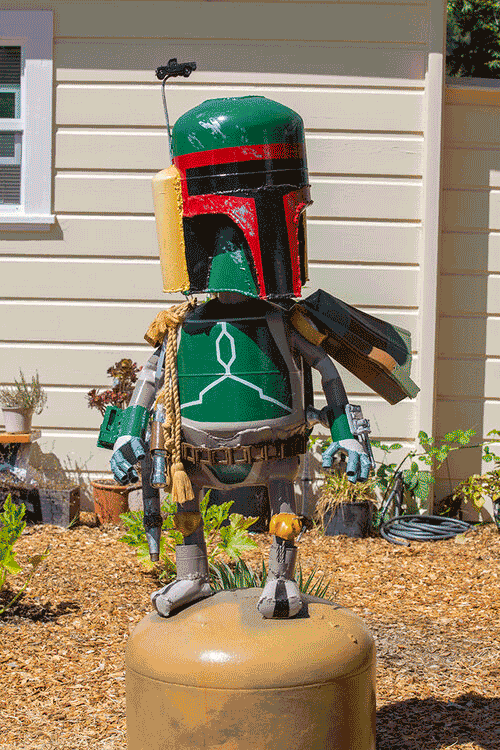
Patrick Amiot & Brigitte Laurent
Patrick Amiot and Brigitte Laurent are Canadian-born artists who have followed their artistic impulses to Sebastopol, California. Amiot is a sculptor at heart, creating large-scale works of junk art that use entirely recycled materials. These sculptures are largely made of steel, welded by Amiot’s practiced hand, and then passed on to Laurent, who brings them alive with colour.
Early in his career, Amiot resided in Toronto as a ceramicist, primarily working with clay. His accidentally-discovered passion for junk art pulled him towards California, where materials are abundant. After settling down in Sebastopol with his family, Amiot ran free with creativity, producing impressively large and incredibly personable sculptures painted by Laurent. Their front lawn was covered in new creations, a strange image in such an ordinary town.
After a few years, Laurent and Amiot became integral to Sebastopol’s identity, their work appearing in more front yards, storefronts, and public areas. As their work became more prolific, Laurent and Amiot also became heavily involved with community causes. Together, alongside a local committee, they champion an annual fundraiser for Sebastopol’s schools and educational institutions.
In no small part due to their work, Sebastopol sees many art-loving tourists and visitors. Amiot and Laurent’s street could very well be an open-air public gallery, inspiring wonder and joy in its visitors. Their work is created in collaboration and cooperation with the community, bringing together stories and people.
For more information, visit https://downtownmarkham.ca/community/carousel/patrick-amiot/.
Arts Help is proudly supported by The Remington Group
